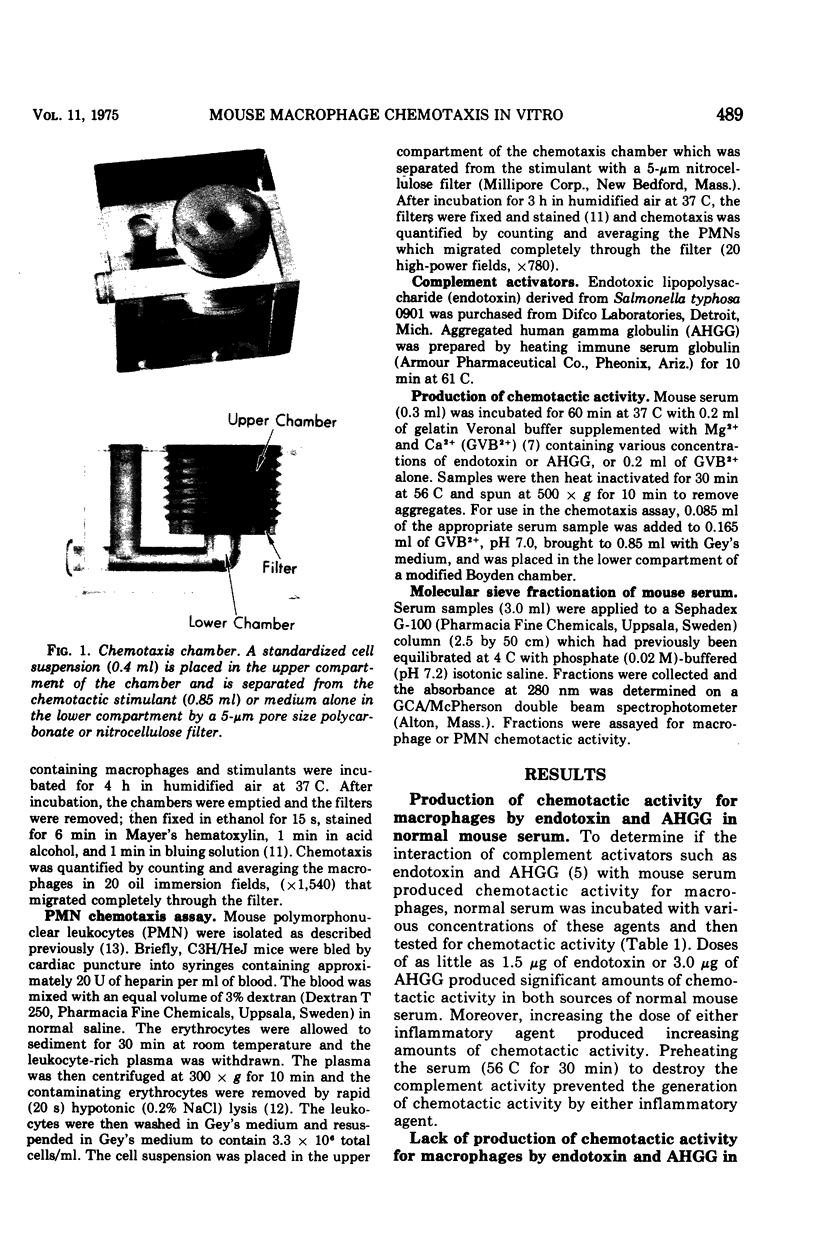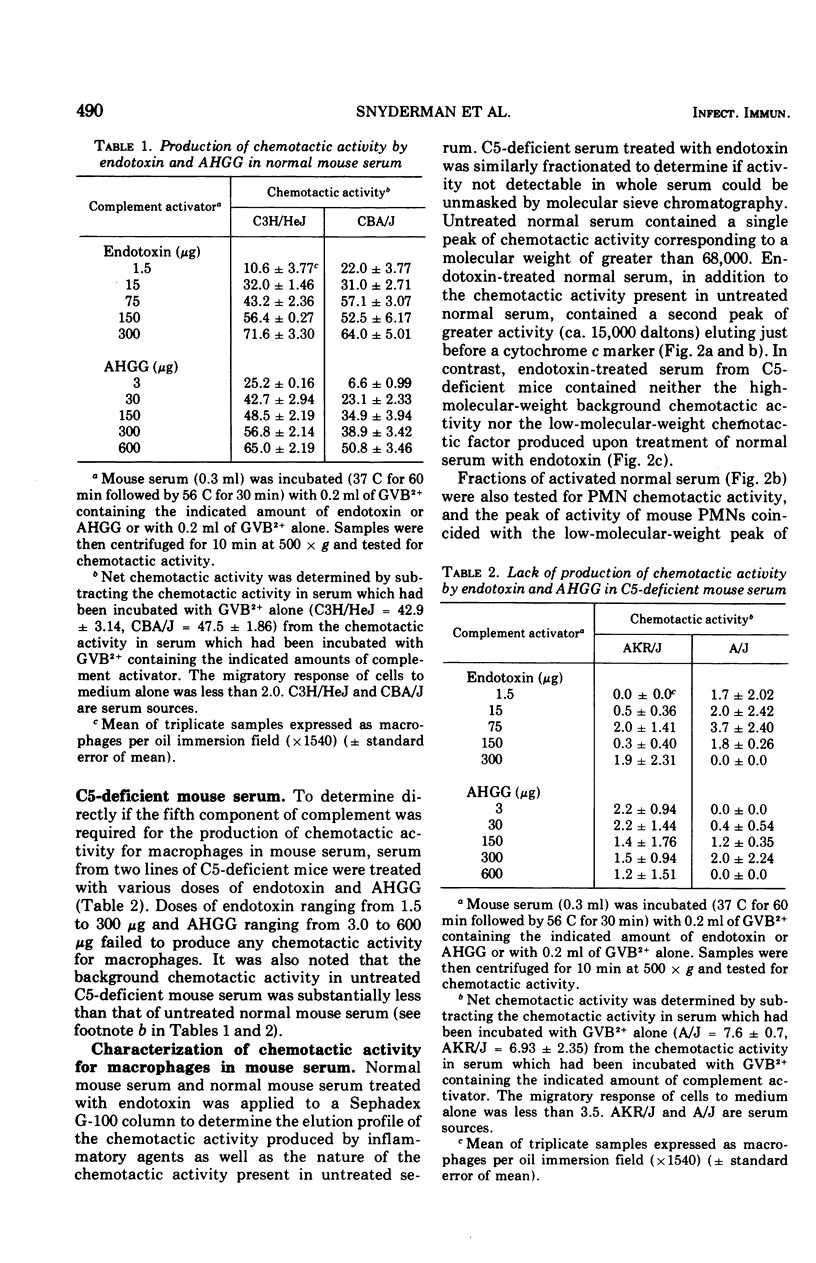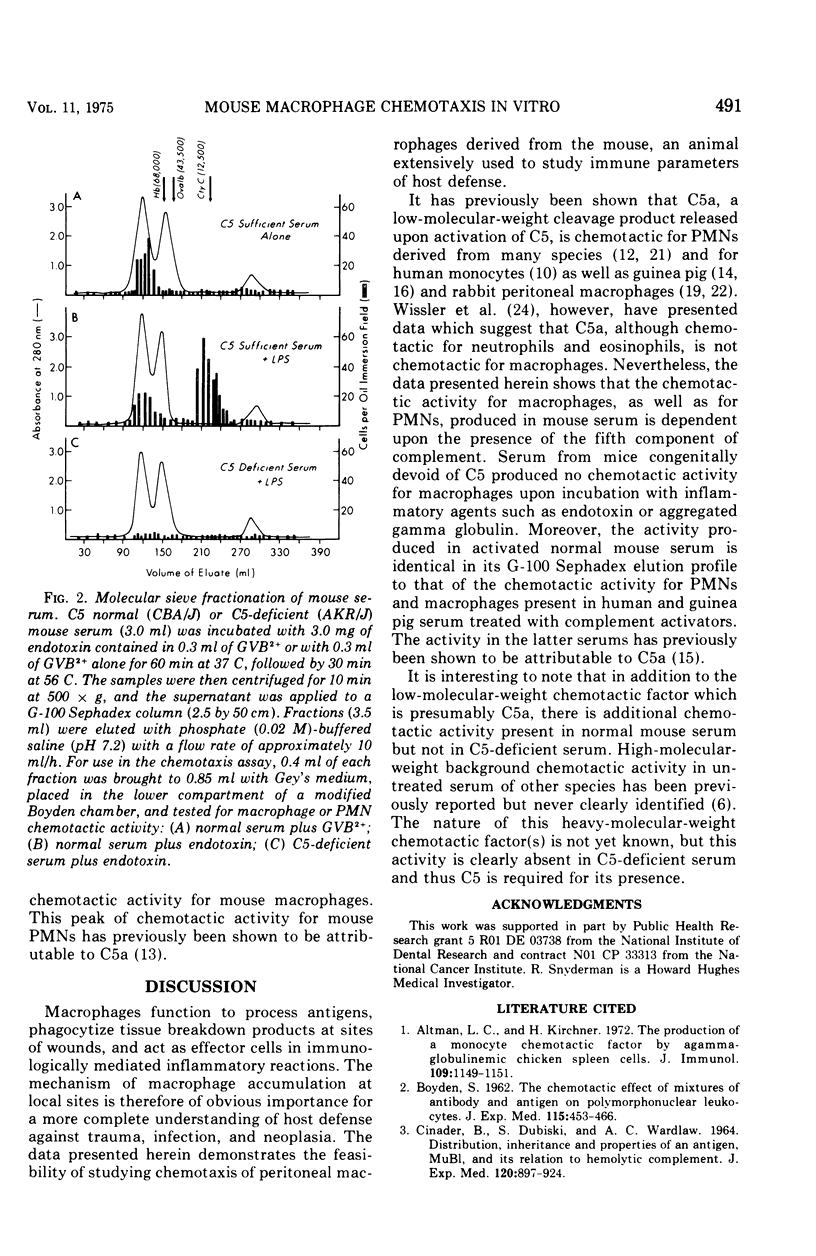Abstract
Delineation of the mechanisms of macrophage accumulation at local tissue sites will further our understanding of immunologically mediated host resistance to infectious and neoplastic diseases. Since mice are frequently used for the study of immune function, we developed a method for the quantification of mouse macrophage chemotaxis in vitro. By this method it was found that the fifth component of complement is necessary for the production of chemotactic activity in mouse serum by inflammatory agents such as endotoxin or aggregated gamma globulin. The majority of macrophage chemotactic activity produced by these agents in mouse serum can be attributed to a low-molecular-weight (ca. 15,000) chemotactic factor. The data suggest that this factor is the biologically active cleavage product of the fifth component of complement, C5a.
Full text
PDF




Images in this article
Selected References
These references are in PubMed. This may not be the complete list of references from this article.
- Altman L. C., Kirchner H. The production of a monocyte chemotactic factor by agammaglobulinemic chicken spleen cells. J Immunol. 1972 Nov;109(5):1149–1151. [PubMed] [Google Scholar]
- BOYDEN S. The chemotactic effect of mixtures of antibody and antigen on polymorphonuclear leucocytes. J Exp Med. 1962 Mar 1;115:453–466. doi: 10.1084/jem.115.3.453. [DOI] [PMC free article] [PubMed] [Google Scholar]
- CINADER B., DUBISKI S., WARDLAW A. C. DISTRIBUTION, INHERITANCE, AND PROPERTIES OF AN ANTIGEN, MUB1, AND ITS RELATION TO HEMOLYTIC COMPLEMENT. J Exp Med. 1964 Nov 1;120:897–924. doi: 10.1084/jem.120.5.897. [DOI] [PMC free article] [PubMed] [Google Scholar]
- ERICKSON R. P., TACHIBANA D. K., HERZENBERG L. A., ROSENBERG L. T. A SINGLE GENE CONTROLLING HEMOLYTIC COMPLEMENT AND A SERUM ANTIGEN IN THE MOUSE. J Immunol. 1964 Apr;92:611–615. [PubMed] [Google Scholar]
- Gewurz H., Shin H. S., Mergenhagen S. E. Interactions of the complement system with endotoxic lipopolysaccharide: consumption of each of the six terminal complement components. J Exp Med. 1968 Nov 1;128(5):1049–1057. doi: 10.1084/jem.128.5.1049. [DOI] [PMC free article] [PubMed] [Google Scholar]
- Hausman M. S., Snyderman R., Mergenhagen S. E. Humoral mediators of chemotaxis of mononuclear leukocytes. J Infect Dis. 1972 Jun;125(6):595–602. doi: 10.1093/infdis/125.6.595. [DOI] [PubMed] [Google Scholar]
- Nilsson U. R., Müller-Eberhard H. J. Deficiency of the fifth component of complement in mice with an inherited complement defect. J Exp Med. 1967 Jan 1;125(1):1–16. doi: 10.1084/jem.125.1.1. [DOI] [PMC free article] [PubMed] [Google Scholar]
- Snyderman R., Altman L. C., Frankel A., Blaese R. M. Defective mononuclear leukocyte chemotaxis: a previously unrecognized immune dysfunction. Studies in a patient with chronic mucocutaneous candidiasis. Ann Intern Med. 1973 Apr;78(4):509–513. doi: 10.7326/0003-4819-78-4-509. [DOI] [PubMed] [Google Scholar]
- Snyderman R., Altman L. C., Hausman M. S., Mergenhagen S. E. Human mononuclear leukocyte chemotaxis: a quantitative assay for humoral and cellular chemotactic factors. J Immunol. 1972 Mar;108(3):857–860. [PubMed] [Google Scholar]
- Snyderman R., Gewurz H., Mergenhagen S. E. Interactions of the complement system with endotoxic lipopolysaccharide. Generation of a factor chemotactic for polymorphonuclear leukocytes. J Exp Med. 1968 Aug 1;128(2):259–275. doi: 10.1084/jem.128.2.259. [DOI] [PMC free article] [PubMed] [Google Scholar]
- Snyderman R., Phillips J. K., Mergenhagen S. E. Biological activity of complement in vivo. Role of C5 in the accumulation of polymorphonuclear leukocytes in inflammatory exudates. J Exp Med. 1971 Nov 1;134(5):1131–1143. doi: 10.1084/jem.134.5.1131. [DOI] [PMC free article] [PubMed] [Google Scholar]
- Snyderman R., Shin H. S., Hausman M. H. A chemotactic factor for mononuclear leukocytes. Proc Soc Exp Biol Med. 1971 Nov;138(2):387–390. doi: 10.3181/00379727-138-35903. [DOI] [PubMed] [Google Scholar]
- Snyderman R., Shin H. S., Phillips J. K., Gewurz H., Mergenhagen S. E. A neutrophil chemotatic factor derived from C'5 upon interaction of guinea pig serum with endotoxin. J Immunol. 1969 Sep;103(3):413–422. [PubMed] [Google Scholar]
- WARD P. A., COCHRANE C. G., MUELLER-EBERHARD H. J. THE ROLE OF SERUM COMPLEMENT IN CHEMOTAXIS OF LEUKOCYTES IN VITRO. J Exp Med. 1965 Aug 1;122:327–346. doi: 10.1084/jem.122.2.327. [DOI] [PMC free article] [PubMed] [Google Scholar]
- Wahl S. M., Altman L. C., Oppenheim J. J., Mergenhagen S. E. In vitro studies of a chemotactic lymphokine in the guinea pig. Int Arch Allergy Appl Immunol. 1974;46(5):768–784. doi: 10.1159/000231176. [DOI] [PubMed] [Google Scholar]
- Ward P. A., Berenberg J. L. Defective regulation of inflammatory mediators in Hodgkin's disease. Supernormal levels of chemotactic-factor inactivator. N Engl J Med. 1974 Jan 10;290(2):76–80. doi: 10.1056/NEJM197401102900203. [DOI] [PubMed] [Google Scholar]
- Ward P. A. Leukotactic factors in health and disease. Am J Pathol. 1971 Sep;64(3):521–530. [PMC free article] [PubMed] [Google Scholar]
- Ward P. A., Newman L. J. A neutrophil chemotactic factor from human C'5. J Immunol. 1969 Jan;102(1):93–99. [PubMed] [Google Scholar]
- Ward P. A., Remold H. G., David J. R. Leukotactic factor produced by sensitized lymphocytes. Science. 1969 Mar 7;163(3871):1079–1081. doi: 10.1126/science.163.3871.1079. [DOI] [PubMed] [Google Scholar]
- Ward P. A., Remold H. G., David J. R. The production by antigen-stimulated lymphocytes of a leukotactic factor distinct from migration inhibitory factor. Cell Immunol. 1970 Jul;1(2):162–174. doi: 10.1016/0008-8749(70)90003-1. [DOI] [PubMed] [Google Scholar]
- Wissler J. H., Stecher V. J., Sorkin E. Biochemistry and biology of a leucotactic binary serum peptide system related to anaphylatoxin. Int Arch Allergy Appl Immunol. 1972;42(5):722–747. doi: 10.1159/000230652. [DOI] [PubMed] [Google Scholar]



